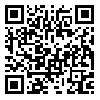شنبه 29 شهریور 1404
دوره 2، شماره 2 - ( 10-1391 )
جلد 2 شماره 2 صفحات 36-29 |
برگشت به فهرست نسخه ها
Download citation:
BibTeX | RIS | EndNote | Medlars | ProCite | Reference Manager | RefWorks
Send citation to:



BibTeX | RIS | EndNote | Medlars | ProCite | Reference Manager | RefWorks
Send citation to:
The relationship between BMI and muscle strength in elderly people living inTehran. PTJ 2013; 2 (2) :29-36
URL: http://ptj.uswr.ac.ir/article-1-95-fa.html
URL: http://ptj.uswr.ac.ir/article-1-95-fa.html
گلچین مقدم زهره، مصلی نژاد زهرا، رحمتی یامی مهدی، ابوطالبی مریم، شهاب علیرضا. The relationship between BMI and muscle strength in elderly people living inTehran. فصلنامه فیزیک درمانی. 1391; 2 (2) :29-36
چکیده: (8590 مشاهده)
Objective: The elderly population is growing in Iran and worldwide. The erderly people living under poor nutrition status may be more susceptible to disability and diseases. BMI(weight divided by square of height) is a quick way to estimate the proportion of weight to height.Sarcopenia can lead to reduced muscle mass and consequently in weight loss and may result in reduced BMI. Sarcopenia can also decrease muscle strength. Present study designed to investigate the relationship between BMI and muscle strength in older adults (65 years and older) living inTehran. Materials & Methods: Pilot study confirmed the instruments reliability. 30 participants (13 women and 17men) were included. Height and weight were measured.Then BMI was calculated. Muscle strength was measured using dynamometer for hands and manual muscle test for legs. Data analysis was performed using SPSS19 software. Non-parametric statistics using the descriptive results, the differences related to sex and relationship facts were compared and analyzed. Results: A total of 30 elderly participated in the study, 17 patients(56/67%) were males and 13 patients(43.33%) females. The mean BMI for women was 23/11 kg/m2 and in men 26/04 kg/m2. More proportion of women were underweight, while the prevalence of obesity was higher in men. Average power 51.97 lb for the right hand and 49.98 lb for the left hand was obtained for the whole population. The gender breakdown, the number obtained for the right hand was 32.08 lb in women and 67.18 lb in men. For the left, it was 29.38 lb and 65.74 lb for women and men, respectively. Muscle strength was higher in men than women in both hands. The results of the lower extremities which was masured by manual muscle testing showed that 7/7% of women and 11/8% of men gained a score of 3(fair) for the right leg,69/2% of women and 23/5% of men met a score of 4(good) and 23/1% of women and 64/7% of men gained 5(normal).Results for the left leg showed that none of the women scored 3 while 17/6% of men gained this score.the same percentage of men received 4 while women dramatically had higher percentage,76/9%. Finally a high percentage of men(76/8%) and a smaller percentage of women(23/1%) gained 5. Conclusion: The findings of this study regarding the relationship between gender and BMI indicate higher mean of BMI in men than women.The means of both left and right hand’s muscle strength were higher in men compared to women. The average of right muscle strenght was grater than left.No significant relation between upper extremities muscle strength and BMI was concluded (p>0.05) but there was a significant relation between lower extremities muscle strength and BMI (p<0.05).
نوع مطالعه: پژوهشي |
موضوع مقاله:
آسیب شناسی ورزشی و حرکات اصلاحی
دریافت: 1392/10/14 | پذیرش: 1392/10/14 | انتشار: 1392/10/14
دریافت: 1392/10/14 | پذیرش: 1392/10/14 | انتشار: 1392/10/14
ارسال پیام به نویسنده مسئول
| بازنشر اطلاعات | |
 |
این مقاله تحت شرایط Creative Commons Attribution-NonCommercial 4.0 International License قابل بازنشر است. |

